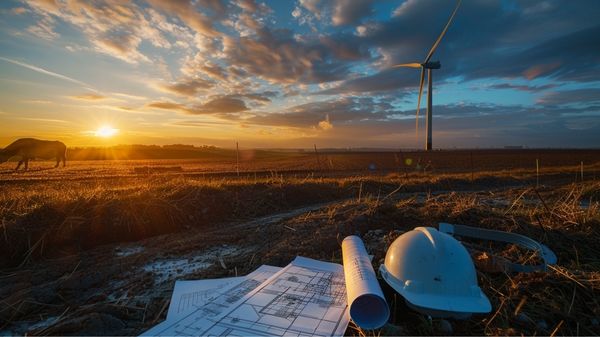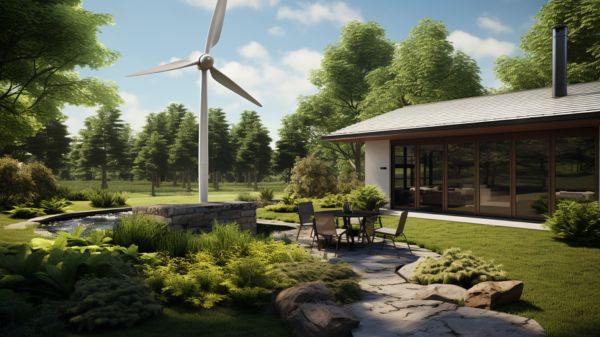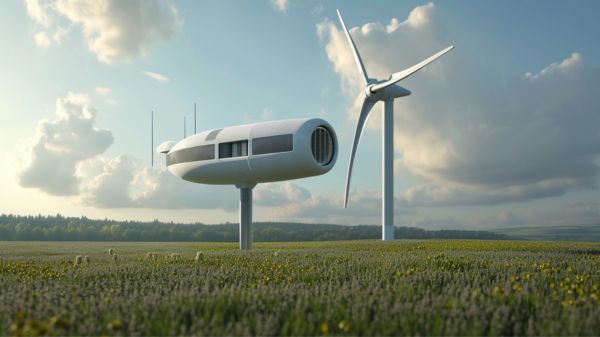Looking to keep your home wind turbine running at its best? We’ve got you covered with 12 essential tips for optimal upkeep. From checking electrical connections to monitoring noise concerns, this article will provide you with the knowledge and know-how to maintain your turbine with ease.
So, buckle up and prepare to take your wind energy game to the next level. Let’s dive into these essential tips for a smoothly operating home wind turbine.
Location and Placement
Choose the best location for your home wind turbine to maximize its efficiency and energy production. The first consideration is the mounting height of the turbine. Ideally, it should be elevated at least 30 feet above any surrounding obstacles, such as buildings or trees, to ensure unobstructed wind flow. This height allows the turbine to capture stronger and more consistent winds, resulting in increased energy generation.
Another crucial factor is wind direction. Conduct a thorough analysis of wind patterns in your area to determine the prevailing direction. Position the turbine so that it faces into the prevailing wind, as this maximizes its exposure to the strongest gusts. Avoid any obstructions, such as tall buildings or hills, that could disrupt the wind flow and reduce the turbine’s efficiency.
Proper Foundation and Mounting
To ensure the stability of your home wind turbine, it’s crucial to have a stable foundation. Choose a location with stable ground that can support the weight and vibrations of the turbine. Additionally, make sure to securely and levelly mount the turbine to the foundation to prevent any unnecessary movement or damage.
Stable Ground for Stability
When installing a home wind turbine, there are two key considerations for ensuring stability: a stable foundation and proper mounting.
To begin with, it is crucial to choose a location that offers a solid and level surface. This ensures stable ground maintenance and provides a sturdy base for the wind turbine. The foundation needs to be capable of withstanding the weight and vibrations generated by the turbine. One effective method for achieving stability is to use a concrete or steel base that is securely anchored into the ground. This helps to minimize movement and guarantees that the turbine remains stable during operation.
In addition to a stable foundation, proper mounting is essential for maintaining stability. The tower should be securely attached to the foundation using strong and durable materials such as steel bolts. This ensures that the turbine remains firmly in place, even in harsh weather conditions.
Regular inspection and maintenance of both the foundation and mounting are necessary to identify any issues and prevent instability. This includes checking for any signs of wear and tear, loose bolts, or shifting in the foundation. By promptly addressing any problems that arise, you can maintain the stability and effectiveness of your home wind turbine system.
Secure and Level Installation
Ensure that you have a stable foundation and proper mounting for your home wind turbine to maintain stability and prevent any issues. The location and accessibility of your wind turbine play a crucial role in its efficiency. Here are three essential factors to consider:
- Ground stability: Choose a location with solid soil or bedrock to provide a secure foundation for your wind turbine. This will help prevent any movement or shifting that could impact its performance.
- Mounting structure: Ensure that the mounting structure is designed to withstand the weight and force of the wind turbine. It should be sturdy and securely anchored to the ground to minimize vibrations and maintain stability.
- Level installation: Properly level the foundation and mounting structure to ensure the wind turbine operates efficiently. This will help reduce stress on the components and optimize its performance.
Regular Visual Inspections
During your regular maintenance routine, make sure to conduct visual inspections of your home wind turbine. Visual inspections are crucial for preventing corrosion and ensuring optimal wind turbine efficiency.
Start by inspecting the turbine blades for any signs of damage, such as cracks or erosion. Pay close attention to the leading edge of the blades, as this area is most susceptible to wear and tear.
Look for any loose or missing bolts, and tighten or replace them as necessary. Examine the tower structure for any signs of rust or deterioration, as this can affect the stability and performance of the turbine.
Additionally, inspect the electrical connections and cables for any damage or loose connections.
Lubrication and Maintenance of Moving Parts
To keep your home wind turbine operating smoothly, it’s important to regularly lubricate and maintain its moving parts. Proper lubrication ensures that the blades rotate efficiently and the gears function smoothly. Here are three essential tips for blade lubrication and gear maintenance:
- Use a high-quality lubricant: Choose a lubricant specifically designed for wind turbines. It should be able to withstand extreme temperatures and provide long-lasting protection against wear and tear.
- Regularly inspect and clean the blades: Check for any signs of damage or debris buildup on the blades. Clean them using a soft brush or cloth to maintain optimal performance.
- Schedule routine gear maintenance: Regularly inspect the gears for any signs of wear, misalignment, or damage. Replace any worn-out or damaged gears promptly to prevent further issues.
Checking and Tightening Electrical Connections
Regularly inspecting and tightening electrical connections is crucial for maintaining the optimal performance of your home wind turbine.
Ensuring the integrity of these connections promotes electrical safety and reduces the risk of damage or malfunction.
Start by visually inspecting all connections for signs of wear, corrosion, or loose wires. Use a multimeter to test the voltage at each connection point to identify any potential issues.
If a connection is loose, use a screwdriver or wrench to tighten it securely. Additionally, consider using electrical tape or wire nuts to secure the connections and prevent them from coming loose over time.
Troubleshooting techniques, such as checking for voltage drops or irregular currents, can help identify any underlying electrical problems that may affect the turbine’s performance.
Regularly monitoring and maintaining electrical connections will ensure the safe and efficient operation of your home wind turbine.
Cleaning and Clearing Debris
To ensure the optimal performance of your home wind turbine, it’s crucial to prevent blade blockages and maintain optimal airflow.
Regular inspection and cleaning of the turbine blades are essential to remove debris and build-up that can hinder the turbine’s efficiency.
Preventing Blade Blockages
Keep blades clear of debris by regularly inspecting and removing any obstructions that may hinder the optimal performance of your home wind turbine. Blade blockages can significantly reduce the efficiency of your turbine, leading to decreased power generation and potential costly repairs.
Here are three essential tips for preventing blade blockages:
- Inspect blades regularly: Conduct routine visual inspections of your turbine blades to identify any signs of debris accumulation or damage. Use binoculars for a closer look if necessary.
- Clean blades carefully: When cleaning the blades, avoid using harsh chemicals or abrasive materials that could cause damage. Instead, use a soft cloth or sponge with mild soap and water to gently wipe away dirt and grime.
- Clear debris promptly: If you notice any debris, such as leaves or bird droppings, on the blades, remove it immediately to prevent blockages and maintain optimal performance.
Maintaining Optimal Airflow
To ensure optimal airflow and prevent blockages, it’s important for you to regularly clean and clear debris from your home wind turbine blades. Maintaining optimal airflow is crucial for maximizing energy output and ensuring efficient operation of your wind turbine.
Over time, debris such as leaves, dirt, and bird droppings can accumulate on the blades, causing turbulence and reducing the efficiency of the turbine. To clean the blades, start by turning off the turbine and ensuring it’s safe to access the blades. Use a soft brush or cloth to gently remove any debris, being careful not to damage the blades.
It’s also essential to regularly inspect and clear any vegetation or other obstructions near the turbine that could impede the airflow.
Regular Inspection and Cleaning
Regularly inspect and clean your home wind turbine to ensure optimal performance and prevent debris buildup. Regular maintenance is essential for preventing rust and extending the lifespan of your wind turbine.
Here are three important tasks you should include in your regular inspection and cleaning routine:
- Clear debris: Regularly check and remove any debris, such as leaves, branches, or bird nests, that may accumulate around the turbine. Debris can disrupt the airflow and reduce the efficiency of the turbine.
- Clean the blades: Use a soft brush or cloth to clean the turbine blades. Dust, dirt, and grime can accumulate on the blades over time, affecting their aerodynamic performance. Regular cleaning helps maintain optimal airflow and turbine efficiency.
- Inspect for damage: Check for any signs of wear, such as cracks or damage to the blades, tower, or other components. Addressing any issues promptly can prevent further damage and ensure the longevity of your wind turbine.
Regular inspection and cleaning are crucial for keeping your home wind turbine in optimal condition, maximizing its performance, and extending its lifespan.
Monitoring and Addressing Vibration Issues
You should regularly monitor and address vibration issues in your home wind turbine to ensure optimal performance. Vibration analysis plays a crucial role in identifying potential problems and preventing major malfunctions.
By using advanced tools and techniques, you can detect abnormal vibrations and take appropriate actions to rectify them. Troubleshooting techniques involve checking for loose bolts or connections, inspecting the condition of the blades, and examining the gearbox and generator for any signs of wear or damage.
It’s important to note that excessive vibration can lead to premature component failure and reduced efficiency. Regularly monitoring and addressing vibration issues won’t only extend the lifespan of your wind turbine but also improve its overall performance and energy production.
Inspecting and Replacing Damaged Blades
To ensure optimal performance of your home wind turbine, it’s crucial to regularly inspect and replace damaged blades.
Proper blade maintenance techniques, such as cleaning and lubricating, can help extend their lifespan and prevent potential issues.
In the event that a blade is beyond repair, cost-effective blade replacements are available to maintain the efficiency and functionality of your wind turbine system.
Blade Maintenance Techniques
When conducting maintenance on your home wind turbine, it’s essential to inspect and replace damaged blades using proper techniques. Blade maintenance is crucial to ensure the optimal performance and longevity of your wind turbine.
Here are some key blade maintenance techniques to consider:
- Blade balancing: Properly balanced blades are necessary for smooth operation and to prevent excessive wear and tear. Regularly check the balance of each blade and make adjustments if needed.
- Inspecting for damage: Regularly inspect your blades for any signs of damage, such as cracks, chips, or erosion. These issues can affect the efficiency and safety of your wind turbine.
- Blade repair techniques: If you notice any damage, it’s important to address it promptly. Depending on the severity, you may need to repair or replace the damaged blade. Consult with a professional to determine the best course of action.
Cost-Effective Blade Replacements
Regularly inspecting and replacing damaged blades is crucial for cost-effective blade replacements in maintaining your home wind turbine.
Damaged blades can negatively impact the performance and efficiency of your turbine, leading to decreased power output and potential costly repairs.
One important aspect to consider during blade replacements is blade balancing. Balancing the blades ensures even distribution of weight, reducing stress on the turbine’s components and enhancing its overall performance.
Additionally, understanding blade aerodynamics is essential for optimal performance. Properly designed blades with the correct shape and angle maximize the capture of wind energy, increasing the turbine’s efficiency.
Regularly inspecting and replacing damaged blades, along with implementing blade balancing techniques and considering blade aerodynamics, will help you maintain a cost-effective and efficient home wind turbine.
Checking and Repairing Tower and Guy Wires
To ensure the optimal performance of your home wind turbine, it’s essential that you regularly inspect and maintain the tower and guy wires.
Neglecting tower maintenance and guy wire inspection can lead to serious consequences such as structural failure, decreased turbine efficiency, and potential safety hazards.
Here are three important steps to follow for checking and repairing tower and guy wires:
- Visual Inspection: Regularly inspect the tower and guy wires for any signs of wear, corrosion, or damage. Look for rust, loose connections, or bent components. Address any issues immediately to prevent further damage.
- Tension Testing: Periodically measure the tension in the guy wires using a tension gauge. This will ensure that they’re properly tensioned and can withstand the wind loads. Adjust the tension as needed to maintain structural integrity.
- Replacement: If any tower or guy wire components are damaged beyond repair, it’s crucial to replace them promptly. Use high-quality materials that meet the manufacturer’s specifications to ensure the structural stability and longevity of your wind turbine.
Monitoring and Addressing Noise Concerns
One important step in maintaining your home wind turbine is monitoring and addressing noise concerns for optimal performance.
Monitoring noise levels is crucial to ensure that your wind turbine is operating within acceptable limits and not causing disturbances in your surroundings. Excessive noise emissions can lead to complaints from neighbors and even legal issues.
Regularly check the noise levels produced by your wind turbine using specialized equipment or by consulting with experts. If noise levels are found to be high, it’s essential to take appropriate measures to reduce noise emissions. This may involve installing noise-reducing features such as acoustic enclosures or modifying the design of the turbine.
Regular Battery Maintenance
Maintain optimal performance for your home wind turbine by regularly maintaining the batteries. Proper battery maintenance techniques can significantly extend the battery lifespan and ensure efficient power storage for your turbine. Here are three essential tips to help you keep your batteries in top condition:
- Regularly inspect the battery terminals for any signs of corrosion or loose connections. Clean the terminals using a mixture of baking soda and water, and tighten any loose connections to prevent power loss.
- Monitor the battery voltage regularly to ensure it remains within the recommended range. Low voltage can indicate a weak battery, while high voltage can lead to overcharging. Adjust the charging settings accordingly to optimize battery performance.
- Keep the batteries in a well-ventilated area to prevent overheating. Excessive heat can reduce battery efficiency and shorten its lifespan. Install proper ventilation or cooling systems if needed.
Professional Maintenance and Servicing
For optimal home wind turbine upkeep, you should consider hiring professionals for maintenance and servicing. These professionals have the necessary professional training and expertise to ensure that your wind turbine operates at its maximum efficiency and reliability. They’re equipped with the knowledge and skills to perform regular inspections, identify potential issues, and carry out necessary repairs or replacements.
Additionally, professionals are well-versed in troubleshooting techniques, allowing them to quickly diagnose and address any problems that may arise. By relying on professionals for maintenance and servicing, you can have peace of mind knowing that your wind turbine is being properly cared for and that any issues will be promptly resolved.
This will ultimately prolong the lifespan of your turbine and maximize its energy production.
Conclusion
In conclusion, maintaining and optimizing your home wind turbine requires regular inspections, proper lubrication, and monitoring of electrical connections and tower wires. While professional maintenance may be necessary at times, regular upkeep can help prevent costly repairs.
While it may seem daunting, with the right knowledge and attention to detail, you can ensure your wind turbine operates efficiently and effectively for years to come. Don’t let the idea of maintenance deter you from harnessing the power of wind energy for your home.




